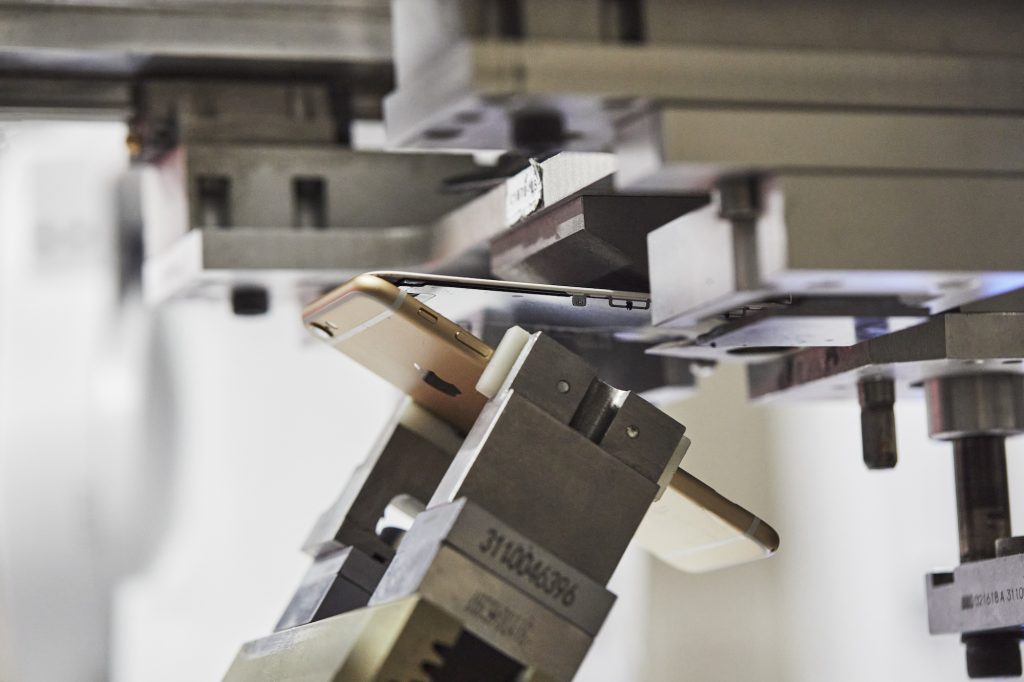Do you believe in reincarnation? Apple, yes. That’s why he imagined Daisy, a robot that takes apart iPhones. Objective: recover as many components as possible to recycle rare and precious metals (gold, tungsten, lithium, tin, cobalt, etc.). This will allow them to be reused in new products. The Californian brand, committed for ten years to reduce your carbon footprint, aims to reduce its environmental impact. In 2021, only 20% of all materials used in the brand’s products were recycled. To go further, it must find new solutions.
Since 2013, Apple has been working to develop a robot that allows the disassembly of iPhones that have become unusable (that cannot be repaired) to retrieve its components. At the time, the Liam 1.0 robot could disassemble an iPhone 5 in 10-15 steps and 12 minutes. Then a new version was released in 2015-2016. Over a length of 30 meters and with 29 robots working, Liam 2.0 could disassemble an iPhone 6 in just 11 seconds. But he didn’t know how to handle different smartphone models. Since 2018, Daisy has changed the game with its ability to handle 23 iPhone models. And last year, Apple recycled twice as many rare and precious metals
Daisy: 4 steps to reverse engineer the iPhone
Direction Breda, 1 hour drive from Amsterdam, the Netherlands. A real European hub for Apple’s activities, this is where the Daisy robot operates. For security reasons, the state-of-the-art machine is housed in an anonymous warehouse in the countryside. 10 meters long, a set of automated arms will disassemble the iPhone in four main steps. The environment is noisy but plexiglass panes contain unwanted splinters. First, a scanner identifies the model of the smartphone. Then he assesses its state (partially bent, twisted?) so that the articulated arm grabs it at the right angle. Because you have to pass a pin under the screen to lift it.
Daisy will then make sure to detach the upper speaker to send it for recycling. Then the device goes into another module. Where cold air at -80°C pulsated at high pressure for 30-45 seconds on the battery causes the glue to crack. This is then struck vigorously to make it detach from the chassis. It is a recycler that will recover the battery and extract the minerals, like lithium.

Photo module, haptic sensors… each element is isolated by Daisy
Third step: another articulated arm pierces the iPhone at the location of the screws and the various component fasteners. This represents between 30 and 60 holes depending on the model. In this way, Apple recovers the screws on one side. On the other, he dismantles the main elements of the device (electronic card, haptic sensors, camera, audio speakers, etc.).

These different components are then extracted using a vibrating arm to, again, facilitate the recycling of rare and precious metals. Finally, the chassis is also insulated so that the already 100% recycled aluminum is recycled again.

Up to 1.2 million iPhones processed per year
Apple is thus aiming for a circular economy, with however some elements that will be recycled by external service providers. Daisy is able to process up to 1.2 million iPhones in this way (about 200 devices per day). But Apple is now limited by the too small number of devices returned by their owners in stores.
In 2022, 5.3 billion smartphones will be thrown away.
Report of the international forum on WEEE.
In 2022, 5.3 billion smartphones will be thrown away, according to a report by the international forum on waste electrical and electronic equipment (WEEE). The brand hopes that its “Trade In” program will make it possible to recover more devices in the years to come. This offers a reduction in the price of his new iPhone in exchange for the return of the old one.

Target zero carbon by 2030, including for its products
Already “zero carbon” on the corporate level, thanks in particular to significant investments in renewable energies, the consumer electronics manufacturer is aiming for carbon neutrality for all its products by 2030. Overall, the firm believes that it must reduce its greenhouse gas emissions by 75% by 2030. For the remaining 25%, this will go through compensation. As with the support of environmental projects in the region of Córdoba, Colombia. There, she works to support the restoration and protection of nearly 11,000 hectares of mangrove forest.
Apple must reduce its greenhouse gas emissions by 75% by 2030.
To achieve its global zero carbon objective, it must also work hand in hand with its 213 suppliers around the world to systematize the use of renewable energies. The brand supports them so that everything is aligned with its objectives by 2030. Already, taking into account the various efforts carried out since 2012, Apple has succeeded in 2021 in reducing its carbon footprint by 50% compared to what it should have been without these measures. But there is still a long way to go before achieving a true circular economy and a neutral carbon footprint.

Share the post “Do you know Daisy, the Apple robot that recycles iPhones?”
We want to give thanks to the author of this short article for this amazing web content
Do you know Daisy, the Apple robot that recycles iPhones? – WE TOMORROW
Find here our social media profiles and other related pageshttps://nimblespirit.com/related-pages/

